
| KIT #: | A05120 |
| PRICE: | $24.95 MSRP |
| DECALS: | Three options |
| REVIEWER: | Scott Van Aken |
| NOTES: | New mold kit |

| HISTORY |
In late 1938, the "Emil" entered production. To improve on the performance afforded by the rather small 447-522 kW (600-700 hp) Jumo, the larger Daimler-Benz DB 601A engine was used, yielding an extra 223 kW (300 hp) at the cost of an additional 181 kg (400 lb). To test the new 1,100 PS (1,085 hp, 809 kW) DB601A engine, two more prototypes (V14 and V15) were built, each differing in their armament. While the V14 was armed with two 7.92 mm (.312 in) MG 17s above the engine and one 20 mm MG FF in each wing, the V15 was fitted with the two MG 17s mounted above the engine only. After test fights the V14 was considered more promising and a pre-production batch of 10 E-0 was ordered. Batches of both E-1 and E-3 variants were shipped to Spain for evaluation, and received their baptism of fire in the final phases of the Spanish Civil War.
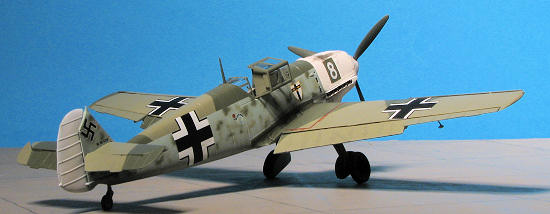 The production version
E-1
kept two 7.92 mm (.312 in) MG 17s above the engine and two more in the
wings. Later, many were modified to the E-3 armament standard. The
E-1B
was a small batch of E-1s becoming the first operational Bf 109 fighter
bomber, or Jagdbomber
(usually abbreviated to Jabo).
These were fitted with either an ETC 250 bomb rack, carrying one 250 kg
(550 lb) bomb, or two ETC 50 bomb racks, each carrying a 50 kg (110 lb) bomb
under both wings. The E-1 was also fitted with the Reflexvisier "Revi"
gunsight. Communications equipment was the FuG 7
Funkgerät 7
(radio set) short-range radio apparatus, effective to ranges of 48–56 km
(30–35 mi). A total of 1,183 E-1 were built, 110 of them were E-1/B.
The production version
E-1
kept two 7.92 mm (.312 in) MG 17s above the engine and two more in the
wings. Later, many were modified to the E-3 armament standard. The
E-1B
was a small batch of E-1s becoming the first operational Bf 109 fighter
bomber, or Jagdbomber
(usually abbreviated to Jabo).
These were fitted with either an ETC 250 bomb rack, carrying one 250 kg
(550 lb) bomb, or two ETC 50 bomb racks, each carrying a 50 kg (110 lb) bomb
under both wings. The E-1 was also fitted with the Reflexvisier "Revi"
gunsight. Communications equipment was the FuG 7
Funkgerät 7
(radio set) short-range radio apparatus, effective to ranges of 48–56 km
(30–35 mi). A total of 1,183 E-1 were built, 110 of them were E-1/B.
Only very limited numbers of the E-2 variant were built, for which the V20 prototype served as basis. It was armed with two wing mounted, and one engine mounted MG FF cannon, which gave considerable trouble in service, as well as two MG 17s cowl machineguns. In August 1940, II./JG 27 was operating this type.
To improve the performance of the Bf 109E,
the last two real prototypes,
V16 and
V17
were constructed. These received some structural improvements and more
powerful armament. Both were the basis of the Bf 109
E-3
version. The E-3 was armed with the two MG 17s above the engine and one MG
FF cannon in each wing.
 A total of 1,276 E-3 were built, including 83
E-3a
export versions. Both the E-1 and E-3 were built at the same time on the
same assembly lines at a ratio of 6 109E-3s for every 4 109E-1s.
A total of 1,276 E-3 were built, including 83
E-3a
export versions. Both the E-1 and E-3 were built at the same time on the
same assembly lines at a ratio of 6 109E-3s for every 4 109E-1s.
E-4
The E-3 was replaced by the E-4 (with many airframes being upgraded to E-4 standards starting at the beginning of the Battle of Britain) which was different in some small details, most notably by using the modified 20 mm MG-FF/M wing cannon and having improved head armor for the pilot. With the MG FF/M it was possible to fire a new and improved type of explosive shell, called Minengeschoß (or 'mine-shell') which was made using drawn steel (the same way brass cartridges are made) instead of being cast as was the usual practice. This resulted in a shell with a thin but strong wall, which had a larger cavity in which to pack a much larger explosive charge than was otherwise possible. The new shell required modifications to the MG FF's mechanism due to the different recoil characteristics, hence the MG FF/M designation.
The cockpit canopy was also revised to an easier-to-produce, "squared-off" design, which also helped improve the pilot's field of view. This canopy, which was also retrofitted to many E-1s and E-3s, was largely unchanged until the introduction of a welded, heavy-framed canopy on the G series in the autumn of 1942. The E-4 would be the basis for all further Bf 109E developments. Some E-4 and later models received a further improved 1,175 PS (1,159 hp, 864 kW) DB601N high-altitude engine; known as the E-4/N this first appeared in July 1940. The E-4 was also available as a fighter-bomber with equipment very similar to the previous E-1/B. It was known as E-4/B (DB 601Aa engine) and E-4/BN (DB 601N engine). A total of 561 of all E-4 versions were built, including 250 E-4, 20 E-4/N, 211 E-4/B and 15 E-4/BN.
| THE KIT |
As you know, Airfix is on a mission to regain its
status as a company that builds kits people want to buy. They are doing so by
not only producing nicely molded and detailed kits, but offering them at a most
reasonable price. This is true of their new mold Bf-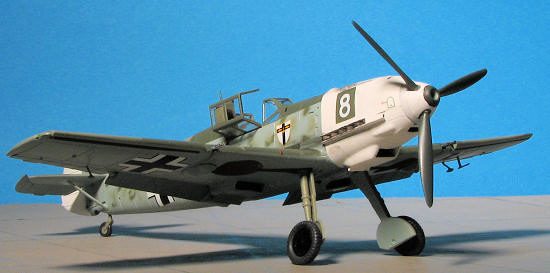 109E as it is easily $15
less expensive than those now offered in the US by Tamiya and Hasegawa, with
detailing that is nearly as good and offering multiple versions in the same
boxing.
109E as it is easily $15
less expensive than those now offered in the US by Tamiya and Hasegawa, with
detailing that is nearly as good and offering multiple versions in the same
boxing.
Let's start with the detailing. What seems to be a bit overdone in 1/72 scale, seems just about right in 1/48. It is still not as petite as what you find on Hasegawa kits and is nearly the same as on Tamiya kits. The plastic has a somewhat matte finish and thanks to good quality control, there are no sink areas near the alignment pins, a real problem with some kits. There are a few inserts to take care of the different variants, specifically the gun position on the wing leading edge where the position of the gun is different on the E-1 as compared to the cannon armed E-3/4 versions.
The cockpit is very nicely done with all the various bits one would expect and that includes sidewall detailing and parts. The seat has a molded in seat harness and Airfix provides a very nicely done three piece pilot in appropriate garb. An engine half is molded into each fuselage half and there are engine mounts to add to the detail. Cementing the upper cowling is an option, though I think most will do just that. Unlike Airfix's competitors, all of the flight control surfaces are separate. This includes the leading edge slats. The flaps have tabs to be in the normal down position, but by removing them you can position them up. Rudder and elevators are also separate to allow them to be more dynamically positioned. Two different upper cowlings are provided. Though not used in this particular boxing, a sand filter is provided for those wanting to use aftermarket desert markings.
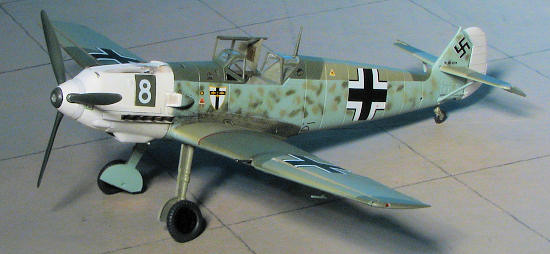 A 'wheels up' option is provided by doors with wheels
halves attached. The kit main wheels are flattered and bulged a bit. The outer
wheel hub is a separate item to assist in painting. For things under the
fusealge, there are ooptions of a drop tank, 250 kg bomb, 500 kg bomb or a tray
with four bombs (I'm guessing 50 or 100 kg). Several different windscreens and
backlights are provided depending on which variant is being done. The
windscreens include one with additional armor and one with a telescopic gunsight.
The main canopy section is molded with tabs on it to pose it open, but one can
cut those away for a closed cockpit. To my eye, the windscreens are not as
nicely done as those on the Tamiya and Hasegawa kits, being a bit thick. Three
different spinners are offered, one with the cannon opening and two pointed
spinners; one more blunt than the other.
A 'wheels up' option is provided by doors with wheels
halves attached. The kit main wheels are flattered and bulged a bit. The outer
wheel hub is a separate item to assist in painting. For things under the
fusealge, there are ooptions of a drop tank, 250 kg bomb, 500 kg bomb or a tray
with four bombs (I'm guessing 50 or 100 kg). Several different windscreens and
backlights are provided depending on which variant is being done. The
windscreens include one with additional armor and one with a telescopic gunsight.
The main canopy section is molded with tabs on it to pose it open, but one can
cut those away for a closed cockpit. To my eye, the windscreens are not as
nicely done as those on the Tamiya and Hasegawa kits, being a bit thick. Three
different spinners are offered, one with the cannon opening and two pointed
spinners; one more blunt than the other.
I know that people will or have picked this one apart already and I'll let them. The only real disconnect I could find is that there are no wing shell ejector chutes. There is an area to be opened if one is using the cannon wings (for the E-3/4 version). I don't recall if the 109E ejected shells or retained them in catch areas to be recycled. If not, one can duplicate these openings with little rectangles of black decal. I also noted that some parts not used may be applicable to an E-7 version. One has to realize that during the Battle of Britain and before, 109Es were not plumbed for drop tanks or even bombs (until late 1940). It was the 109E-7 that introduced the ability to carry a drop tank and of course, this and the bomb thing was retrofitted to the earlier versions.
Instructions are well done and the 43 construction steps are easy to follow.
Airfix continues their irritating habit of using Humbrol numbers for paints
rather than telling us what the shade actually is. The only place that is
provided is in the
 full color painting and markings guide. There are three decal
options. One is for the yellow-nose box art plane, a 109E-4/N of Adolf Galland
with JG 26 in late 1940. The next is a 109E-3 of JG 51 from July 1940. It has
the honor of being the first Luftwaffe fighter shot down over the UK. The third
option is a 109E-1/B fighter bomber from LG2 in September 1940. This aircraft
has also been retrofitted with an E-4 windscreen and canopy. All three are
in 'slate grey/US light green' over 'aircraft blue'; in other words, RLM
71/02/65. The decal sheet is well printed and includes full data markings, but
no swastikas. Time to break out the swastika sheets for this and other Airfix
kits.
full color painting and markings guide. There are three decal
options. One is for the yellow-nose box art plane, a 109E-4/N of Adolf Galland
with JG 26 in late 1940. The next is a 109E-3 of JG 51 from July 1940. It has
the honor of being the first Luftwaffe fighter shot down over the UK. The third
option is a 109E-1/B fighter bomber from LG2 in September 1940. This aircraft
has also been retrofitted with an E-4 windscreen and canopy. All three are
in 'slate grey/US light green' over 'aircraft blue'; in other words, RLM
71/02/65. The decal sheet is well printed and includes full data markings, but
no swastikas. Time to break out the swastika sheets for this and other Airfix
kits.
| CONSTRUCTION |
It seems that if I don't start on a kit soon after purchase, it tends to languish, sometimes for years. Fortunately, I had just finished one so felt justified to start another. So it is with this one. As I'd already previewed two Pavla upgrade sets for this kit (Pavla U 48-35: Bf-109E wing radiator, wheels, exhaust and guns and Pavla U 48-36: Bf-109E Flight Control Surfaces), it seems I had all I needed to do one up good. Interestingly, Pavla seems to have decided that the cockpit is fine and has not developed a resin one for it (at least not yet).
First thing I did was to decide on which version I'm going to build as it will make a difference during construction. I picked an E-4 variant as I had an 'E' decal sheet I've been working on to build all or most of the options in it. It is Aeromaster 48-249 "Marauding Emils Pt.IV". I've used two of the schemes and there are three left, all of them E-4 versions.
Next, I opened up the holes for the under wing cannon bulges
and glued the wing halves together. The upper wing has a bit of a step near the
tip, but wa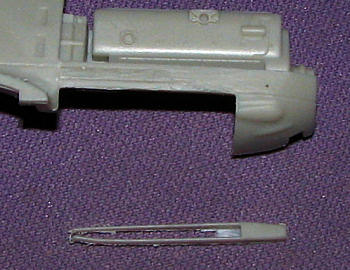 s easily sanded
down without loss of detail. Next, I had to cut off the exhaust from the kit to
use the much nicer ones from Pavla. This was easily accomplished with a razor
saw, leaving a slight indentation towards the aft portion of the cut away area.
The Pavla exhaust (which are hollowed out) have a small 'ramp' of resin towards
the rear that fits into this hollowed out
s easily sanded
down without loss of detail. Next, I had to cut off the exhaust from the kit to
use the much nicer ones from Pavla. This was easily accomplished with a razor
saw, leaving a slight indentation towards the aft portion of the cut away area.
The Pavla exhaust (which are hollowed out) have a small 'ramp' of resin towards
the rear that fits into this hollowed out
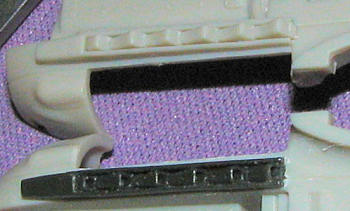 section. A bit of trimming is
needed for a tight fit, but it takes all of a few minutes to make a big
improvement. You can perhaps see this in the image after the exhaust housing was
cut away. This is a one time shot on gluing this so much test fitting is needed
to be sure all fits properly. However, I think you'll agree that the result is
worth it.
section. A bit of trimming is
needed for a tight fit, but it takes all of a few minutes to make a big
improvement. You can perhaps see this in the image after the exhaust housing was
cut away. This is a one time shot on gluing this so much test fitting is needed
to be sure all fits properly. However, I think you'll agree that the result is
worth it.
With the exhaust on, I went to the interior. This is all
pretty straightforward stuff and the detailing here is pretty good as well. On
the bulkheads, one attaches a throttle quadrant to one side and the oxygen
canister to the other. There is good radio and map holder detail there for you.
I found that the molded in harness was pretty, well, lame. You get raised belt
areas, but no buckles or other detail. This cries out for aftermarket and
fortunately for us all,
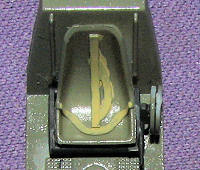 Eduard
does a color Luftwaffe fighters harness set that has one for the 109E. It really
makes things look a lot better. The cockpit also has a nicely done control stick
and trim wheels. The
Eduard
does a color Luftwaffe fighters harness set that has one for the 109E. It really
makes things look a lot better. The cockpit also has a nicely done control stick
and trim wheels. The
 seat and the frame are separate items as well. The
instrument panel was painted and glued in place in the cockpit tub. I trapped
the cockpit between the fuselage halves while the glue dried on this to be sure
all was aligned properly. Once that happened, I glued the spinner back plate to
the prop shaft and trapped that in between the fuselage halves, glued in the
cockpit and glued the halves together. Naturally, there were seams so all of
those got the super glue treatment.
seat and the frame are separate items as well. The
instrument panel was painted and glued in place in the cockpit tub. I trapped
the cockpit between the fuselage halves while the glue dried on this to be sure
all was aligned properly. Once that happened, I glued the spinner back plate to
the prop shaft and trapped that in between the fuselage halves, glued in the
cockpit and glued the halves together. Naturally, there were seams so all of
those got the super glue treatment.
While all that was drying and being sanded, I went back to
work on the wings. At this time I glued in the cannon inserts. The fit really
isn't very good on this, and frankly, I wasn't surprised as inserts often cause
problems. It required considerable filling as they were not quite as thick as
the wing leading edge, but were finally in place. Reaching for the Pavla bits,
the under wing radiators were installed. These are not quite as long as the kit
parts, so there is a gap in front of the small 'forks' that needs filling. When
that was done, I glued the wing in place on the now sanded down fuselage. T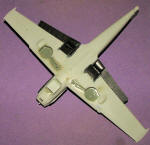 he
fit is really very good. There is a gap at the lower rear, but the upper root is
perfect, requiring no trimming or filler.
he
fit is really very good. There is a gap at the lower rear, but the upper root is
perfect, requiring no trimming or filler.
I then cemented the rounded radiator exhaust forms (I don't know what else to call them) onto the Pavla resin replacement flaps. Then the flaps were glued on in the lowered position. The lower cowling had the radiator piece glued in and the cap atop it. I had to completely remove the alignment pins on this cap piece. There is a bar that goes across it that kept it from fitting all the way down. Now it could be that I installed the radiator piece upside down, but if not, then you'll have to do the same thing as did I. It was then just pressed into place on the lower cowling. It is a very tight fit as you can see from the image.
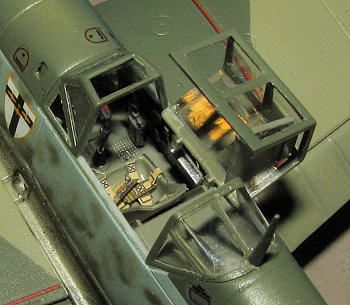
Moving on, I glued on the horizontal stabilizers. Be careful not to trim off a small piece at the root which looks like a sprue gate. I tried to set them up without the brace to ease painting, but in the end, I had to glue in the braces to keep the stabs from drooping down before the glue set properly. The resin rudder and ailerons were glued on, followed by the elevators. I guess I could have held off on the rudder until after it was painted, but it makes no difference. The small radiator coolant doors were the next pieces to be cemented in place, these also coming from the Pavla resin set.
Flipping over the airframe, I glued in the gun sight and then started on the canopy bits. The Airfix canopy pieces are a bit thick, but otherwise fairly well done. I found it odd that the frames near the top of the molding in all the pieces were somewhat indistinct. Not sure why that is, but it isn't as crisply molded as one finds on other 1/48 109E kits. The aft section and windscreen were glued in place, and I noticed that these parts were a little bit narrower than the area into which they fit. You can see this in the image to the right. As I wanted to pose the canopy open, I couldn't use the one for this variant as it would require me to cut off the tabs that held it open. Fortunately, the E-1/3 canopy wasn't going to be needed so it was press fit into place after cutting off the tabs. The fit is quite tight and it will do a super job of keeping out the overspray.
| COLORS & MARKINGS |
As I mentioned, I am using a third option from Aeromaster 48-249 Marauding Emil's part IV.
This aircraft was flown by Gefreiter Nittmann of 7./JG 27 in September 1940.
Rarely do I get to use more than one option from a sheet, but this time, I'm
going to try to use as many from this one as I can. The plane is in RLM 71/02/65
and for this one, I used all Testors Model Master enamels. First the nose and
rudder were painted white. Then that was masked off and the underside and side
RLM 65 was sprayed on. Next was the RLM 02 for the upper surface. There was a
lot of overspray onto the side for this, but it matters not as I'll eventually
spray that area with the RLM 65 later.
am using a third option from Aeromaster 48-249 Marauding Emil's part IV.
This aircraft was flown by Gefreiter Nittmann of 7./JG 27 in September 1940.
Rarely do I get to use more than one option from a sheet, but this time, I'm
going to try to use as many from this one as I can. The plane is in RLM 71/02/65
and for this one, I used all Testors Model Master enamels. First the nose and
rudder were painted white. Then that was masked off and the underside and side
RLM 65 was sprayed on. Next was the RLM 02 for the upper surface. There was a
lot of overspray onto the side for this, but it matters not as I'll eventually
spray that area with the RLM 65 later.
 For
this one, rather than go freehand, I decided to mask off the colors. The
demarcation line on these planes is pretty tight anyway so in this scale,
masking is a viable option. At least, that is my story and I'm sticking with it.
Once the RLM 02 was masked, I sprayed on the RLM 71. Later that was all masked
and the RLM 65 was touched up. One thing about spray painting is that if you
don't want overspray on something, it has to be masked. For m
For
this one, rather than go freehand, I decided to mask off the colors. The
demarcation line on these planes is pretty tight anyway so in this scale,
masking is a viable option. At least, that is my story and I'm sticking with it.
Once the RLM 02 was masked, I sprayed on the RLM 71. Later that was all masked
and the RLM 65 was touched up. One thing about spray painting is that if you
don't want overspray on something, it has to be masked. For m e that means using
a considerable amount of masking tape. Light mottling was then done on the sides
in RLM 02 and 71. There was the usual touch up stuff that seems to be the norm
with me and eventually, all the colors were applied.
e that means using
a considerable amount of masking tape. Light mottling was then done on the sides
in RLM 02 and 71. There was the usual touch up stuff that seems to be the norm
with me and eventually, all the colors were applied.
The next step was to install the main landing gear and the tail gear. This was done after wrapping the main oleos with Bare Metal Foil Chrome. fit of both was very good and the main gear especially was a nice, positive fit. When dry, a coat of clear gloss acrylic was applied in preparation for decals. The sheet I used isn't exactly new, having a 1997 date on it. I expected no problems, but discovered that a couple of the insignia were starting to crack, with one breaking into three large pieces. Fitting it back together wasn't an issue, though one that had just split in the middle was a total loss and had to be replaced by a kit marking. I also used many of the data markings from the kit sheet. Eventually all the markings from the sheet were applied. I had to spray some RLM 71 onto decal paper to duplicate the section of the nose that was masked off along with the aircraft number before applying the white. For stencils, I used the kit decals. Some of these silvered, despite being put onto a gloss surface and using setting solution.
| CONSTRUCTION CONTINUES |
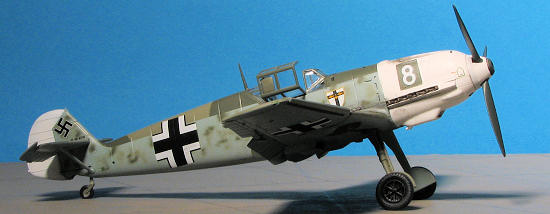 With the decals on, I continued to
attach pieces. The wheels and gear doors were glued into place. I built up
the prop and hub after painting them and they were attached. I also glued on
the aileron mass balances and the pitot tube to the underside of the wing. A
coat of semi-matte clear was sprayed on to seal in the decals. Next, the
masking was removed from the clear bits and I tossed the temporary canopy.
Installation of the head armor was accomplished using clear paint. Tamiya
pastels provided the soot for the exhaust and the guns. The final bits to
install were the wing cannon barrels. These Pavla bits are very nicely done.
One went in with no problems, but the second slipped in to far and stuck
there. Attempts to remove it were futile as the super glue was holding on
too much. Eventually, it broke off. With the kit gun barrels gone, I had no
choice but to improvise. It is always something. The canopy section
was glued on and the model was done.
With the decals on, I continued to
attach pieces. The wheels and gear doors were glued into place. I built up
the prop and hub after painting them and they were attached. I also glued on
the aileron mass balances and the pitot tube to the underside of the wing. A
coat of semi-matte clear was sprayed on to seal in the decals. Next, the
masking was removed from the clear bits and I tossed the temporary canopy.
Installation of the head armor was accomplished using clear paint. Tamiya
pastels provided the soot for the exhaust and the guns. The final bits to
install were the wing cannon barrels. These Pavla bits are very nicely done.
One went in with no problems, but the second slipped in to far and stuck
there. Attempts to remove it were futile as the super glue was holding on
too much. Eventually, it broke off. With the kit gun barrels gone, I had no
choice but to improvise. It is always something. The canopy section
was glued on and the model was done.
| CONCLUSIONS |
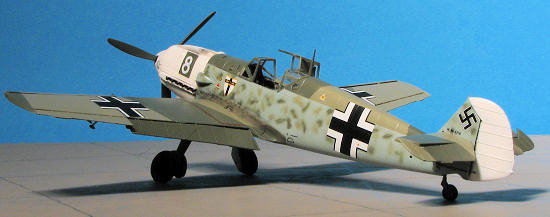 This really is a nice kit. To its plus, it does
three different variants and has loads of weapons. The wing fits snugly and in
general, it has very good fit. The wing gun insert is probably the worst fitting
item in the kit and I'm not totally jazzed with the decals. It is a real plus
having separate flight control surfaces, though I did find the clear bits a bit
thick with the definition of the frame lines not as crisp as I've found on other
kits. Still, it is nothing really major.
This really is a nice kit. To its plus, it does
three different variants and has loads of weapons. The wing fits snugly and in
general, it has very good fit. The wing gun insert is probably the worst fitting
item in the kit and I'm not totally jazzed with the decals. It is a real plus
having separate flight control surfaces, though I did find the clear bits a bit
thick with the definition of the frame lines not as crisp as I've found on other
kits. Still, it is nothing really major.
Now I did use two Pavla resin sets on this one and they do add a level of detail not found on the kit. The gun barrels and exhaust are particularly well done as are the wheels. However, for most, this set isn't really necessary, though it is nice. Overall, I'd have to say that this one offers real value for the money and is one I think you'll enjoy as well.
| REFERENCES |
October 2010
Thanks to me for the kit and Pavla Models for the resin bits.
If you would like your product reviewed fairly and quickly, please contact me or see other details in the Note to Contributors.